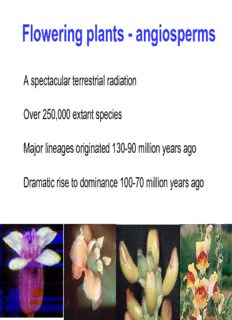
Flowering plants - angiosperms PDF
Preview Flowering plants - angiosperms
Flowering plants - angiosperms A spectacular terrestrial radiation Over 250,000 extant species Major lineages originated 130-90 million years ago Dramatic rise to dominance 100-70 million years ago We’re Coordinated Angiosperm phylogenetics has been highly collaborative (e.g., Donoghue and Doyle 1989; Chase et al. 1993; Chase et al. 1993; D. Soltis et al., 1997, 2000; Hoot et al. 1999; Qiu et al. 1999, 2000; P. Soltis et al., 1999; Olmstead et al. 2000; Savolainen et al. 2000; Zanis et al. 2002; Hilu et al. 2003) There have been numerous collaborations among the PIs Analyses of sequences from all three plant genomes have identified major clades New classifications have been proposed (APG 1998; APG II 2003); also collaborative, and involving the PIs. Summary tree Based on Soltis et a. 2000 Triaperturate with modifications from pollen Zanis et al. 2002, Soltis et al. 2003 Illiciu m Amborella Cabomba The “Dirty Dozen” FIG. 1A ANmAybumosCrptemrehoClrlaaobahecnatloaToeoimRlpcraercaoaehaeoyncgaynatshtlneullheaBoonaSscdulPccieaiexuSCderaxnaGolsaaraiedctfaeubelreresaniaaaasCsgnclAeceuaeeeelslctraariaPHcaenceeiDelaagdeeremiaiasapid pecahaiPh selymalnacialGNlaleilaaeepiPniaylccosihcdcnheeenSyetacyaakialaaletcieeagoarceMAccilcenaaoeieoazacebaBaleocclDaeueaaaeHtgiscacadSaieeeceniletloaeaPCaelarpeaecgoeAacheenracectyaoAcuthataeesCalmaeacpactaceaoAeeeraarcryasacmeaSoPteenerpnihatpmrRhhaoyeaPaymhtspcalcaeoeleocaebnliayenDacadageadceeiocloeesaCledenaiaearaenMaseocenitlasVeyeeedscruasrirttoeiGraaaedosaclcseesoeeersiOmdaaa xneeaIHGEaIita aulu(oPilmdlaepueuCacshpastlearo ileaavsarrsMyi.cnbedL oeljiasi.iancvaEl)cpaaaePleiaCrccgaoaetelhiBcduenaaieosHaoaeeaiscOncayeteenpcecCPaaeeehmhaeVetarnirsiaaiecayosccascBileefacoelaaaocebaAleereaaaecaaenlS hcaHseoaaen.LupIlrlaC.ariaimacvaectccaiec einirsecsenaig.aaetPaloePie.caePaelh maoeLcseiycnpaoe.allrdhl.epatoaIaaoheExdnccnooretReehyanpnathaaZcayhdeieecxnyzrreiaoagtKodhaexcoparaeyeaphcCclamhaeoeeeycaraelaRleaeleracasaFoecCtecsaFreBaeaaubaaeeallScaeegereulasbsaernelsbetriasitdalaolelpesssidales 4. SAXIFRAGALES 5. CARYOPHYLLIDS 8. MALPIGHIALES 7. BASAL FABIDS 6. BASAL ROSIDS 3. CORE EUDICOTS 2. BASAL EUDICOTS 1. BASAL ANGIOSPERMS FIG. 1B GSunCaxnaierfryraBaolgpeSeashrablyneeDltslraiiilddlaBlsCoelMTaepnolsesisraatianrrdcmacaFaelgmlaieoernPeseuasaorvqciSliuseeaytiamcaDemeecroiiaepaanSealpcioetaeeTyMc cnasrhae.esaacleaic.eeaoeaPaacpcrseehMeiaamraceayeeuEsratlsbaSaeiLeccnaneeeapacaacoeyceetEetaahCarceiieecydCaaraAleiccelecletRahataSiceorenaaeriPrcaidrdeeeiauaaTnclectehaaencepaOieaGehaacnycaeecelraaIoareccyetaGheacaeleieecnnsSB aastocPio.calelrel.anVaoaanaegceaalonhelCsieslapiTsaOacerecellrteeeamramaeSaaceccatehhaAnaolcneecenigPaaadenBeecrltdaeiihVagcaaaceelnecieaLoareLaebcneaeaeeineamantBcieabieMycauaecbPelaaelaarOiearudtieyrlaaoonccPbwieeahaaaSncyneeeciSrcaarmthcoPielaepalbcaachaGeeneucCataeleaeaaesraglrneeciiPAemnaeercaoqianecaluitaaecnaiCreaefipioneaaahlgemcirR aeaAplCagoeaesBmuosntselruausrulteamanaTalcPcieecraeeosliecEaalblaieeyeEesaeaocrlcreaeaseecmmlmaleeoaTaao niecSsosnPi.eypraliaer.nnhciengeacePnac enaAaeelorlnapaisQCatetciiecaraaumelycpieapneroseihatAnfieionaadlaccoiceaexeacaaaeeeceaeea es.l. rosids 12. CAMPANULIDS 9. ERICALES 11. LAMIALES 10. BASAL LAMIIDS 3. CORE EUDICOTS Angiosperm AToL goals Multigene and genomics approaches (entire plastid sequences) to clarify the framework of angiosperm phylogeny, focusing on 12 particularly problematic nodes (“dirty, but doable”) Identify non-molecular synapomorphies and initiate a comprehensive morphological database for angiosperms with a suite of key features Angiosperm AToL sequencing Plastid genome sequences Whole plastid sequencing for 30 species; collaboration with R. Jansen and the Green Plant AToL to compile a data set of ~100 entire plastid sequences Targeted sequencing Sequence 17 genes of proven utility from 370 genera selected to span each of the 12 problematic nodes. Resolve relationships within Malpighiales, Lamiales, Ericales, and Campanulids, using additional DNA regions and taxa. Angiosperm AToL morphology Selected morphological features recorded from 370 taxa in DNA analyses; first-hand observations of herbarium and living material Observations available in a morphological database (e.g., MorphBank, F. Ronquist) Three suites of characters emphasized: pollen morphology, leaf architecture, and wood/stem anatomy
Description: